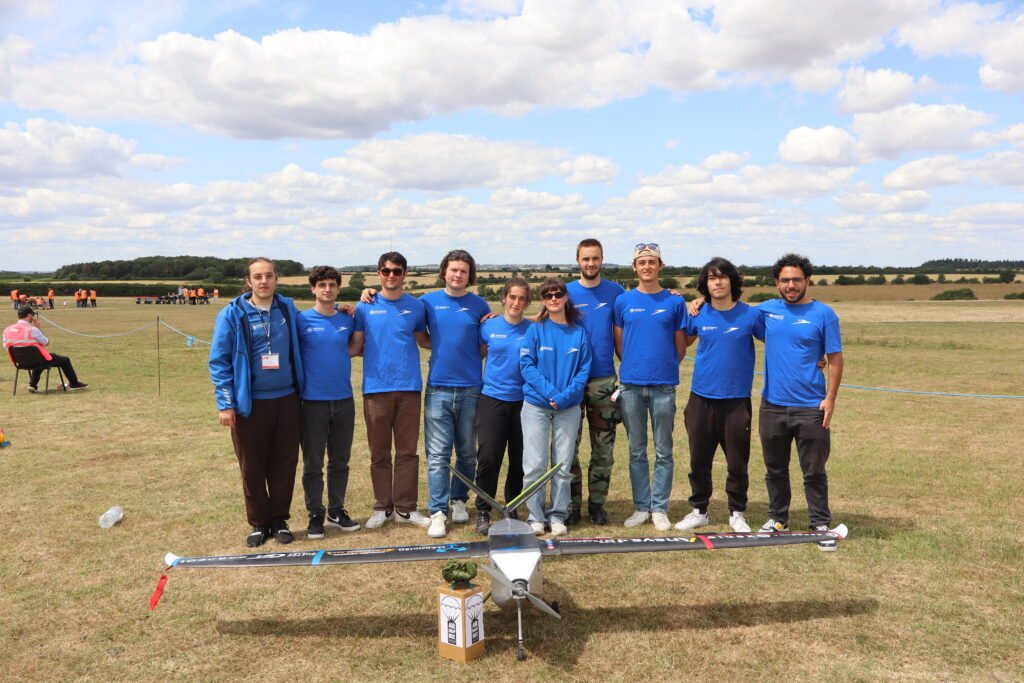O.L.I.V.I.A.
- Home
- O.L.I.V.I.A.
The project
O.L.I.V.I.A. (Optimised Lightweight Intelligent Vehicle for Immediate Assistance) is an unmanned aerial vehicle (UAV) with full-automatic flight capabilities, designed for the delivery of humanitarian aid in emergencies. Its purpose is to provide logistical support in areas affected by natural disasters, ensuring fast, efficient and safe transport of essential goods to isolated areas.
The O.L.I.V.I.A. project was developed by Fly-Mi EUROAVIA Milano during the 2024/25 academic year to participate in the UAS Challenge 2025. The aircraft was awarded 3rd place out of 42 participants in the competition, also winning the Safety Award, a prize awarded for the safety of the solutions adopted on the drone.

UAS Challenge 2025
O.L.I.V.I.A. was developed to compete with 41 other university student teams in the UAS Challenge 2025. The competition involved building an aircraft (fixed-wing or rotary-wing) capable of carrying a 2.5 kg jettisonable payload along a route of approximately 15 km. The payload had to be released in flight in a predetermined area, where it would land thanks to the parachute with which the box was equipped. The main goal of the competition was to complete the mission as quickly and efficiently as possible, but above all in a fully automatic manner: take-off, navigation through waypoints, payload release and aircraft landing had to take place programmatically, without any intervention by the competition pilot.
O.L.I.V.I.A.
The team met all the competition requirements by creating O.L.I.V.I.A., the association’s first fully automatic drone. Let’s take a closer look at its specifications.
Flight characteristics:
- Configurazione tradizionale monomotore con coda posteriore a V e ala alta, per garantire stabilità ed efficienza in volo.
- Carrello a triciclo anteriore con smorzatore, per favorire atterraggi su terreni impervi.
- Maximum payload: 2.5 kg
- Range when fully loaded: 15 km
- Endurance: 15 minutes
- Wing surface: 0.85 m²
- Wing span: 3.2 m
- Cruise speed: 15 m/s
- Stall speed: 8.5 m/s
- Maximum speed: 35 m/s
Structure and Materials
- Fuselage made with carbon fibre and Nomex honeycomb sandwich panels to ensure maximum rigidity and reduced structural weight.
- Ali in carbonio realizzate in stampo chiuso e curate in autoclave.
- Empty mass: 5.5 kg
- MTOM: 8 kg
- Maximum load factor: 3 g
Electronics and propulsion
- Motor: T-Motor AT4120 KV560
- Shaft power: 1800 W
- Static thrust during take-off: 8 kg
- Main battery module: LiPo 6S 4200 mAh
- Separate power supply configuration with an auxiliary battery for engine and avionics, to ensure aircraft control in the event of propulsion failure..
- Flight controller with ArduPilot firmware, for planning automatic missions, power supply and management of sensors, servomotors and radio receivers, reconstruction of aircraft position and attitude, telemetry generation, black box log on SD card, navigation system, fly-by-wire and automatic modes, failsafe system in case of geofence breach, radio loss or other critical system errors.
- Buzzer to locate the drone following a crash by means of an acoustic signal.
- Dual redundant GPS module to improve location accuracy and provide backup in case of failure.
- Sensors: 6-axis IMU (accelerometer and gyroscope), barometer, current and voltage sensors for both power supplies, temperature sensors for MCU and ESC, Pitot tube, unidirectional LiDAR to improve landing.
- Radio receivers: 2 Radiomaster RP4TD-M 2.4 GHz True Diversity modules with ExpressLRS protocol, one for the link with the radio control + telemetry, one for the link with the GCS (PC with Mission Planner).
- Maximum range for radio communications (tested): 1 km
